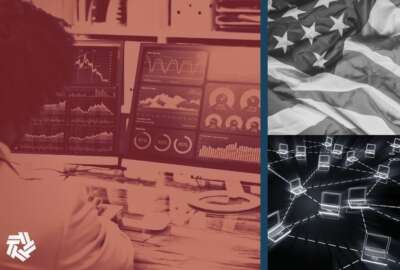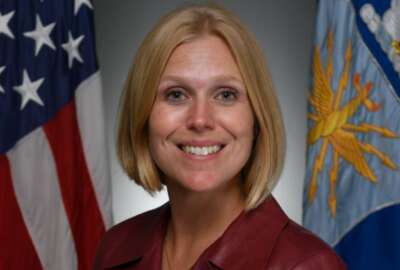
This deputy cost chief knows a fair price when she sees one
In order to know whether they get a fair price for something, the armed forces need to know the cost of making it. That's where the cost estimating and discovery...
In order to know whether they get a fair price for something, the armed forces need to know the cost of making it. That’s where the cost estimating and discovery part of acquisition comes in. For her work, the Federal Drive with Tom Temin spoke with Stephanie Quintal, deputy cost chief of the Air Force. She won one of this year’s Defense Acquisition Workforce Awards.
Interview transcript:
Tom Temin
You just joined this unit at Hanscom, but at the time of the award, you had a different job. Tell us about that.Stephanie Quintal
Sure. So I’ll kind of give you a little bit of background of where I come from and what I do now. I studied mathematics in college. I got a bachelor’s from UMass Lowell. Basically, a math nerd my entire life: puzzles, logic, the whole thing. I got a job out of college, actually, writing textbook math equations. It wasn’t totally for me. I’m definitely more of a social type of person, that wasn’t kind of a job that fit what I wanted forever. So I went back to school, I got a master’s in math at UMass Lowell. And at the time, I was kind of looking for a job that would allow me to be part of a team, but also use my math skills. And I found my Air Force. So I started as a contractor, I was a contractor for about a year, and then moved over to the civilian side of the house, all on Hanscom. I was a trainee. So I did three years in the trainee program and landed in Kessel Run. So what Kessel Run is, it’s the Air Force’s first organic software factory. And it’s basically, all out of Hanscom Air Force Base. And what we did was, we stood up the first organic factory in downtown Boston. And the reasoning there is, to kind of think a little bit outside of the traditional government work and figure out how we can hire and retain better software acquisition talent. And I was a founding member there. So I was there for four or five years. And then this past June, I had an opportunity to move into a different branch. And now I work as a branch cost chief for ITaaS, which is enterprise IT as a service. And what we do is, support the Air Force IT network connections to over 750,000 airmen and guardians. So definitely two different things. But like, so cool on both ends.Tom Temin
But the tying theme is, that you try to figure out what things ought to be priced at. Based on what the cost inputs are?Stephanie Quintal
Basically, what I do is, I collect data from sneeze and apply a model to predict programs future costs. So many people ask why we need process meaning Air Force. And I could go on and on. But to keep it short, we help leadership make strategic decisions, in not only our budget year, but our future years. So something that is like a huge part of my job is, I am in charge of basically submitting a POM or a Program Objective Memorandum. And what that does is, that collects inputs on a program. We were able to take those inputs and basically put a cost model to decide, how much funding we’re going to need, not only in this year. But the way that the Air Force works is, we’re looking way out and how we can allocate funding for resources and requirements through future years.Tom Temin
And does this draw on your mathematical skills beyond simply addition and subtraction?Stephanie Quintal
Yeah, of course. And that’s kind of like the fun part of the job. I always tell the people I work with, the data you give me only helps the cost model. The better the data I get, the better my cost model can be. And so there’s four main types of cost estimating. So the first is an analogy. So this is used normally early on in cost estimating. So what we take is a analogous program, maybe something similar in design or operations, and basically apply what we see for costs in a previous program and apply it to our new program. The next one is my favorite as a cost estimator, that is a parametric relationship. And what that does is, that uses regression or some sort of statistical model to develop a cost estimating relationship, with one or more independent variables. So that is where like my math weakness comes in. And I’m able to go down a little bit of a rabbit hole and see what I can come up with. The third one is engineering. So that is what I honestly use and see the most. So that’s built from a bottoms up. So that’s like, we’re drilling down at a very lower level and basically summing all those parts together. The challenge there is, we have to know what those bottoms up, what the lower levels are, in order to create a cost model there. And then the fourth is actuals, which is we already seen costs for this, we know exactly what it’s going to cost and we can apply those.Tom Temin
We’re speaking with Stephanie Quintal, she is a branch cost lead for the Air Force at Hanscom Air Force Base. And you’ve been doing this a while, you are the recipient of one of this year’s Defense Acquisition Workforce awards to civilians. What do you think you did that netted of this award?Stephanie Quintal
So my award was for contributions as a founding member of Kessel Run. The Kessel Run mission is, to deliver war winning software our airmen love and kind of think a little bit outside of the box to how we can be better at developing software for the Air Force. So what I did was, provided a strategic vision for over $2 billion of requirements across three product lines for Kessel Run. I had a ton of cost estimating updates. And I enabled several dozen contract awards, for 75 external and internal teams supporting over 10,000 users for the Air Force.Tom Temin
So that was basically then a matter of labor cost input?Stephanie Quintal
Sure, yeah. Mostly labor cost input. A challenge there is, when you don’t know what you’re estimating, it’s really hard to estimate. You don’t know what you’re buying, so you don’t know what it’s gonna cost. So what we did is, as we stood up teams in Kessel Run, I basically tracked all the manning requirements. So as people were coming in and falling off these small internal and external teams, I was tracking how many people were working those teams, and what that skill mix looked like. So for example, let’s say, Product A needs a program manager, two developmental engineers, and a designer. And that lasts for eight weeks. But after eight weeks, maybe the product is at some point where an engineer may be able to fall off. So kind of tracking what that manning looks like over time, and developing a cost model for a ramp up, a steady state and a ramp down. And what those labor rates look like, how many people are on each team allows for a better cost model for a development team and how much that costs.Tom Temin
So which method was that of the four then? Would that be engineering?Stephanie Quintal
Sure. Yeah, that’s engineering, you’re ready to be a cost estimator.Tom Temin
Well, I’ve been hearing and writing about this stuff for 30 years, but I’m not sure I could actually do it myself. But is there anything that you learned, say in cost estimation and ultimately price evaluation of software development? And I imagine this was agile and all of this, it was Kessel Run. Does that apply to hardware or other services?Stephanie Quintal
Yeah, it’s more so like, the forward thinking, I think is the best thing I’ve learned. It’s just thinking outside of the box, and kind of knowing that, maybe, you don’t know what you don’t know. And I think that’s important. But thinking outside of the box, and figuring a way to estimate things and leaning on other people that might be better. Leaning on other cost estimators that might know more, is super helpful. I know we’ve had a ton of people reach out to Kessel run, most in the cost estimating. And just asking, hey, how did you do this? How did you estimate a dev team? Do you really know what you’re estimating? Things like that and being able to help each other, because sharing knowledge across branches is so valuable.Tom Temin
Now you look like one of those younger or earlier career people that agencies across the government say they want. Certainly, you’ve got the enthusiasm and knowledge for this. What’s your long term goal here?Stephanie Quintal
My long term goal is to keep providing what I can to the Air Force, in terms of cost estimating knowledge and expertise. I love working with trainees, I love mentoring people. That’s kind of one of my favorite parts of my job, is having someone who might be new to the Air Force, but has a fire for math. And I’m like, that was me. So anything I can transfer to other people, I love to help out. And that goes with other functionals as well. I can’t tell you how many times people pull me aside and they’re like, Hey, can we talk about the POM or, hey, can we talk about cost estimating, what do you do? And it’s like, the more I can give back to the Air Force, I’m all for it. And just keep learning and keep growing.Tom Temin
Well, someone that is reveling in the POM process. That’s a rare cat also, I would say, because most people want to get away from it as far as they can. And it sounds like to you, mathematics is more than just a way of calculating things, but kind of a reference mode of thinking.Stephanie Quintal
Sure, definitely. I’ve always loved math. I am definitely science and math have been something, I think I’ve been naturally blessed to be good at. Growing up I was always good in math in school and at a college I was kind of thinking what I wanted to do. And I thought about possibly doing like academia teaching and the best part of my job is, the fact that I can look back and know that I’m making a difference. And seeing what I do and knowing that it brings capability to the warfighter. Like that’s kind of what keeps me fired up in my job and wanting to do better and wanting to give back more.Tom Temin
Well, I think the Air Force ought to get you out to Palmdale ASAP to get on that bomber. You’d go if they sent you?Stephanie Quintal
Of course.
Copyright © 2025 Federal News Network. All rights reserved. This website is not intended for users located within the European Economic Area.
Tom Temin is host of the Federal Drive and has been providing insight on federal technology and management issues for more than 30 years.
Follow @tteminWFED
Related Stories





